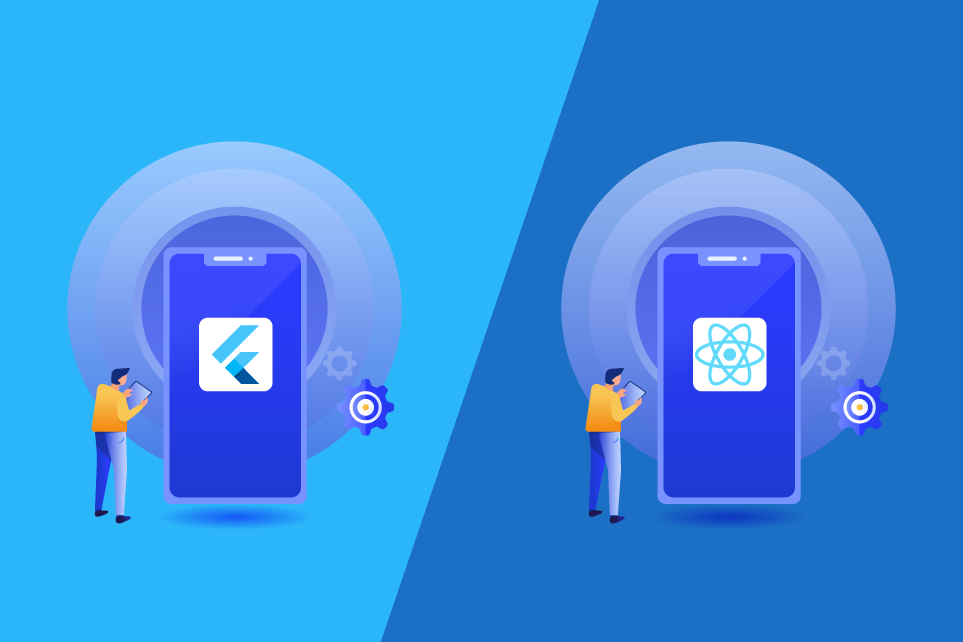Choosing between React Native and Flutter for app development depends on various factors, including development speed, performance, community support, and the specific needs of your project. Here’s a detailed comparison to help you decide which platform might be better for your situation:
1. Language
React Native: Uses JavaScript, a language widely known by web developers.
- Pros: If your team is already familiar with JavaScript or TypeScript, the learning curve will be minimal.
- Cons: JavaScript’s dynamic nature can sometimes lead to runtime errors that are harder to catch early.
Flutter: Uses Dart, a language developed by Google.
- Pros: Dart is easy to pick up for developers familiar with object-oriented programming. It provides ahead-of-time (AOT) compilation, which improves app startup times.
- Cons: Dart is less commonly known than JavaScript, which might require additional learning for your team.
2. Performance
React Native: Uses a bridge to communicate between JavaScript and native modules.
- Pros: Good performance for many use cases, but might require native code for performance-critical components.
- Cons: The bridge can introduce performance bottlenecks, especially for complex animations or intensive graphics.
Flutter: Compiles to native ARM code and uses the Skia graphics engine.
- Pros: It generally offers better performance than React Native because it doesn’t rely on a bridge. Flutter apps often feel more fluid and responsive.
- Cons: The binary size of Flutter apps can be larger than React Native apps.
3. Development Experience
React Native: Provides hot reloading, allowing developers to see changes instantly.
- Pros: Mature ecosystem with numerous libraries and third-party plugins.
- Cons: Managing native dependencies can sometimes be challenging.
Flutter: Offers hot reload, which is highly effective for quick iterations.
- Pros: It comes with a rich set of pre-designed widgets that follow the Material Design and Cupertino style guidelines.
- Cons: Fewer third-party libraries compared to React Native, though this is rapidly changing.
4. Community and Ecosystem
React Native: Backed by Facebook and has a large, active community.
- Pros: Extensive community support, numerous tutorials, and a wide range of third-party libraries.
- Cons: Community-driven plugins can vary in quality.
Flutter: Backed by Google and is growing quickly in popularity.
- Pros: Strong support from Google, comprehensive documentation, and an active community.
- Cons: Smaller ecosystem compared to React Native, but it’s growing.
5. UI Components and Customization
React Native: Relies on native components for rendering.
- Pros: Native look and feel on both iOS and Android.
- Cons: Customizing components to look the same across platforms can be challenging.
Flutter: Uses its own rendering engine and provides a consistent look across platforms.
- Pros: Highly customizable UI components with the ability to create complex, custom widgets.
- Cons: The Flutter look might differ slightly from native components unless meticulously customized.
6. Company Support and Usage
React Native: Used by companies like Facebook, Instagram, Airbnb (though Airbnb has since moved away from React Native), and many others.
- Pros: Proven track record in production environments.
- Cons: Some high-profile companies have reported challenges with React Native and moved to other solutions.
Flutter: Used by companies like Google (for their own products like Google Ads), Alibaba, and others.
- Pros: Increasing adoption by large companies, indicating confidence in the platform.
- Cons: Slightly newer in the market compared to React Native.
7. Future Prospects
React Native: Continuously improving with Facebook’s support and community contributions.
- Pros: Stable, with a well-defined roadmap.
- Cons: May face increased competition from Flutter and other frameworks.
Flutter: Rapidly evolving with strong backing from Google.
- Pros: Growing ecosystem and increasing adoption indicate a strong future.
- Cons: Needs to catch up in terms of third-party libraries and plugins compared to React Native.
Conclusion
Choose React Native if:
- Your team is already proficient in JavaScript/TypeScript.
- You need a large number of third-party libraries and community support.
- You prioritize a native look and feel on both platforms.
Choose Flutter if:
- You want superior performance with smooth animations and graphics.
- You prefer a highly customizable and consistent UI across platforms.
- You’re willing to adopt Dart and leverage Google’s growing ecosystem.
Ultimately, the choice depends on your specific project requirements, team expertise, and long-term maintenance considerations. Both platforms are capable of delivering high-quality cross-platform apps.
We at Appletech adopt the latest technology and incorporate it into our Application Development process. Want to get your app developed? Get in touch with us.

